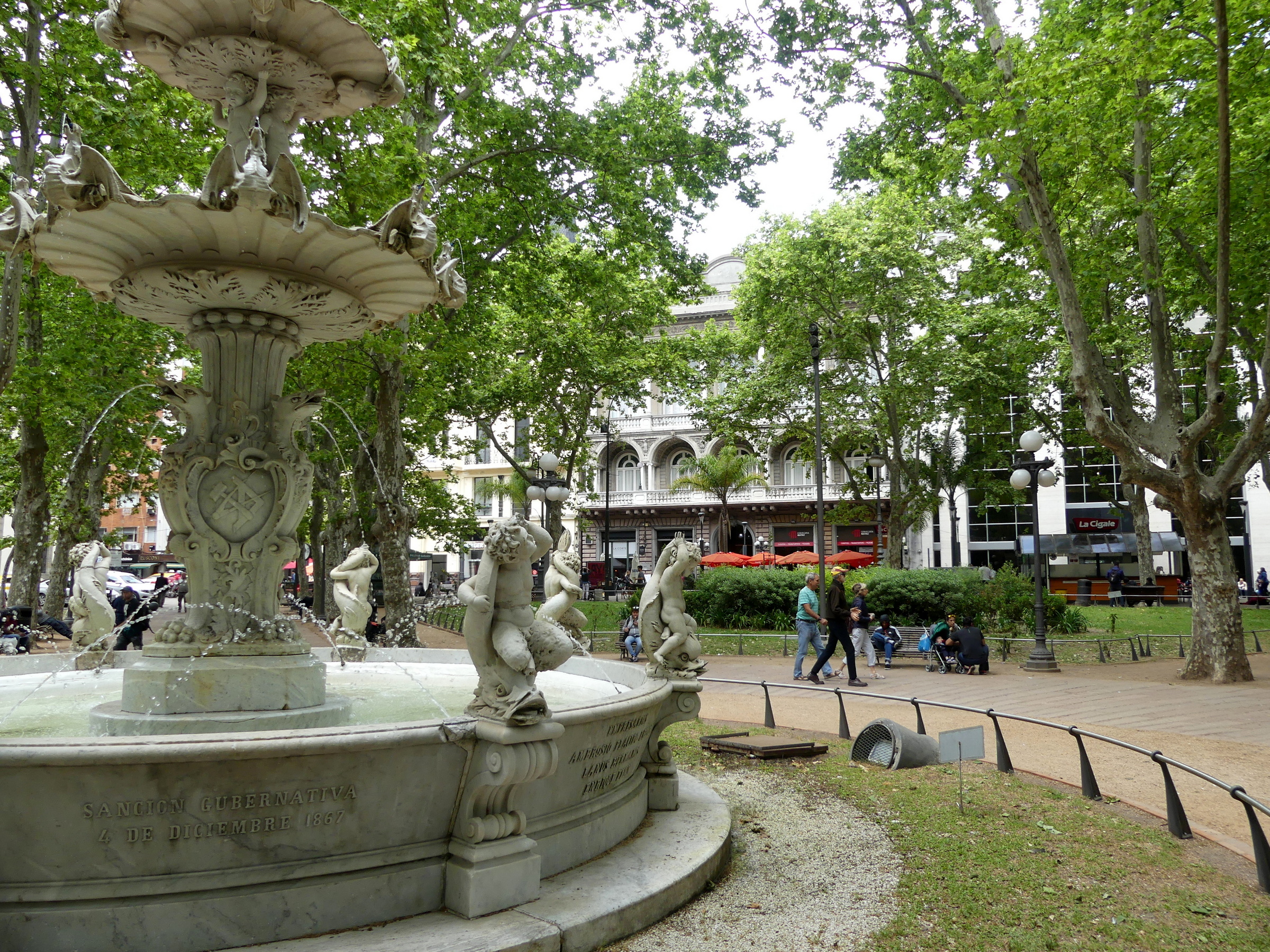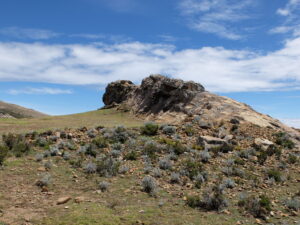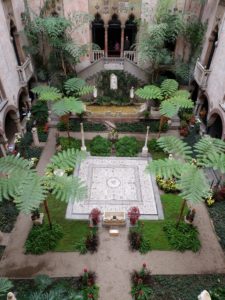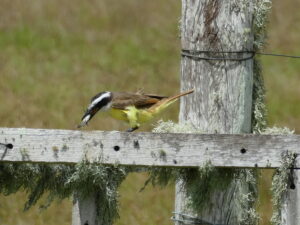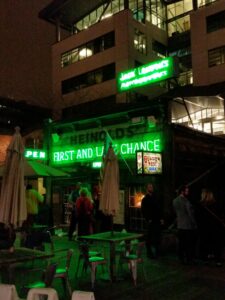In brief: With a seemingly endless sandy beach front, popular neighborhood resources, a charming center, and a relaxed air, Montevideo can be a pleasant place to live.
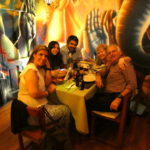
We chose Montevideo, capital of Uruguay, as our home for the six months spanning the end of 2018 and the beginning of 2019. The country is about the size of Missouri, but with a population of only 3.5 million. Just 1.5 million live in the city itself, which is much more relaxed, congenial and laid-back than the huge cities of neighboring Argentina and Brazil.

And most of them seem to stroll about sipping from their bulbous mugs while clutching their thermoses of mate, a kind of bitter tea – the addiction of choice around here. Or walking the dog(s). Montevideo is very friendly to pets, with owners and mascotas keeping each other company along the streets or across the parks.
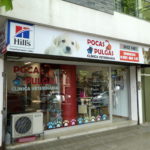
And Montevideo has so much to offer including extensive beachfront, parks and open air markets.
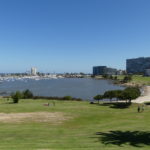
Perhaps its most striking feature, one that Montevideans delight in, is about 25 kilometers (15 miles) of public beachfront. Along its whole length, a ‘rambla’ lets you cruise – by foot, skates, bike or even windsurf. For much of that beachfront, medium-rise apartment buildings line the roadway, each with a beach view; farther out from the central city, however, a surprising number of individual houses remain.
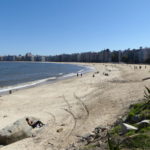
With tides going in and out, the coast feels like an ocean, but we’re actually on the widest river in the world, the Rio de la Plata. Upriver by ferry is Rio de Janeiro – either 2 hours directly via very speedy ferry or by a combo of bus and ferry via Colonia up the coast.
Along the beachfront, as well as inland throughout the city, there is plenty of greenspace and parkland like this, readily enjoyed in Uruguay’s temperate climate. Traffic is light even in rush hour, partly because an extensive network of noisy diesel buses (under $1 USD per trip) takes you wherever you want to go.
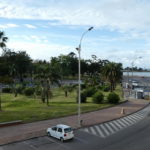
Our apartment looks out on one of these large parks, Parque Rodo, less than a block from the rambla and beachfront. It’s named for a famous Uruguayan poet. And it’s always busy, full of people on nice evenings and weekends. On Sunday, artisans and vendors of all sorts of goods take over a big piece of the park. In the afternoon and evening, we often hear the beat of Uruguay’s favorite music, Candombe, as a host of drummers bring their barrel-shaped wood drums – tambores – into the park to pound on.
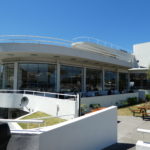
At several major intersections along the beachfront, bars and restaurants offer places to relax for people enjoying the ramblas. Near us is one of these gathering spots with perhaps the most attractive McDonald’s restaurant in the world, an art deco structure that must have seen some other usage awhile ago.
After moving here, we discovered how interesting a culture we had chosen. This has long been a social democracy somewhat different from neighboring ones. Unlike neighboring Brazil and Argentina, from which Uruguay was carved out in the mid-19th century, religion and government are completely separated, a split enshrined in Uruguay’s constitution. Healthcare and education through university are free to all. Marijuana is legal to grow and smoke, but not for foreigners to purchase. Though tobacco is freely available to adults, e-cigarette goods are banned. The leaders of the country, including the President, are typically seen without any security guards, walking about the streets or chatting up locals at cafes. It’s an easy going place.
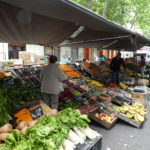
Unlike people in many South American cities, Montevideans tend to shop for daily items in small tiendas instead of central produce markets. The few big shopping malls in town do attract plenty of customers, as they can offer so much in one place, but the hearty tiendas still serve the daily needs of the population. We have dozens with a few minutes walk from us. The other customary source for food is the pop-up feria – or open air market. Every day in every neighborhood, it seems, a feria takes over a local street and attracts plenty of shoppers to the fresh produce.
When you compare the old town to a major city like Buenos Aires, Montevideo’s central district cannot boast of extensive tourist attractions, though its plazas, parks and veteran buildings are worth seeing, as we did for several hours with a “free” walking tour. (We love the increasingly popular “free” walking tours of cities we visit, as we learn so much about the history, culture and attractions of a city. The “free” is in quotes because tipping of the guide is how they can afford to deliver the service.)
Here are some of the most memorable areas.
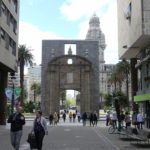
The central plaza of the newer part of the central city, Plaza de Independencia. On one side stands a gate, the last vestige of the old defensive city walls which once crossed the plaza site. At the far side of the plaza rises an Italianate tower, designed as were so many other structures here by an Italian architect. A clone of a building in central Buenos Aires, it served as a short-lived luxury hotel before turning into offices and apartments.
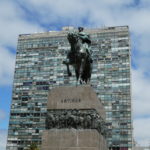
In the middle of the open plaza, a huge statue honors Jose Gervasio Artigas, the founding father of Uruguay. He fought for independence from Spain as well as Portugal and protected the rights of the peasant population – though he lived much of his 86 years elsewhere. The US and French revolutions inspired him. Sadly, he is somewhat dishonored by that ugly high-rise behind him.
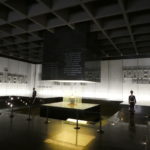
Below the statue is a cavernous hall, where two honorary soldiers always stand beside the urn containing his ashes. The muted lighting together with the boldly carved memories of his life and words are pretty impressive.

Nearby is the main performing hall of Montevideo, Teatro Solis, which was designed in the late 19th century for the rich and famous to gather, but is now renovated and open to the public for theatre, dance and music performances.
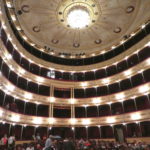
During our first few weeks, we missed some interesting concerts as the end of the high season drew close. But we did manage to catch an excellent Comedia Nacional performance of Moliere’s “Tartuffe” at the theatre. We might not have understood all of the rapid fire dialogue, especially with our partial grasp of the Uruguayan accent (not ‘yo’ for the word ‘I’, but ‘djo’, for example).

Still, a French play in a Spanish translation…Why not? ¿Por que no? Pourquoi pas? And we did have a good opportunity to savor the lovely interior.

A pedestrian street leads from this somewhat newer part to the oldest part of the city. Like most of the vehicular streets, it is lined by a mix of gracious older buildings and unimaginative newer ones. One mural along this byway is the work of a note painter from Uruguay, Joaquín Torres-García. On the ground, furthermore, you can follow the Walk of Fame, where plaques adorned with the multi-rayed sun of the Uruguayan flag honor an odd array of personages. There weren’t enough famous Uruguayans to honor, so one plaque celebrates the Rolling Stones because they came to Montevideo twice, not just once, while another remembers an accountant for some reason.
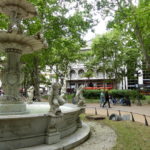
The center of the old town is the charming central plaza, Plaza Constitucion, a classic colonial square, shaded with trees and open to the street. The cathedral lies on one side, the city government on another, and a central fountain focuses attention in the middle for good measure. On the fountain pedestal is carved a Masonic emblem, for Masons have long been strong in the leadership of the country, as in the United States.
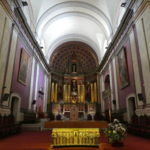
The exterior of the cathedral is fairly uninteresting, but the interior features a glowing apse, with a stunning modern altarpiece.
A few blocks away is Plaza Zambala, designed to imitate a Parisian park complete with an iron fence – and oddly skewed 45 degrees from the street grid.
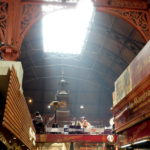
Near the very busy commercial port and ferry terminal, a number of narrow streets abut the 19th century Mercado del Puerto, the iron and wood structure that housed Montevideo’s central market for foods and goods. Now it consists of restaurants and vendors of local products, mostly for the delight of tourists off the ferries or the cruise ships docked nearby.
Perhaps the food sales are best left to the tiendas and ferias anyway.
(Also, for more pictures from Uruguay, CLICK HERE to view the slideshow at the end of the itinerary page.)


